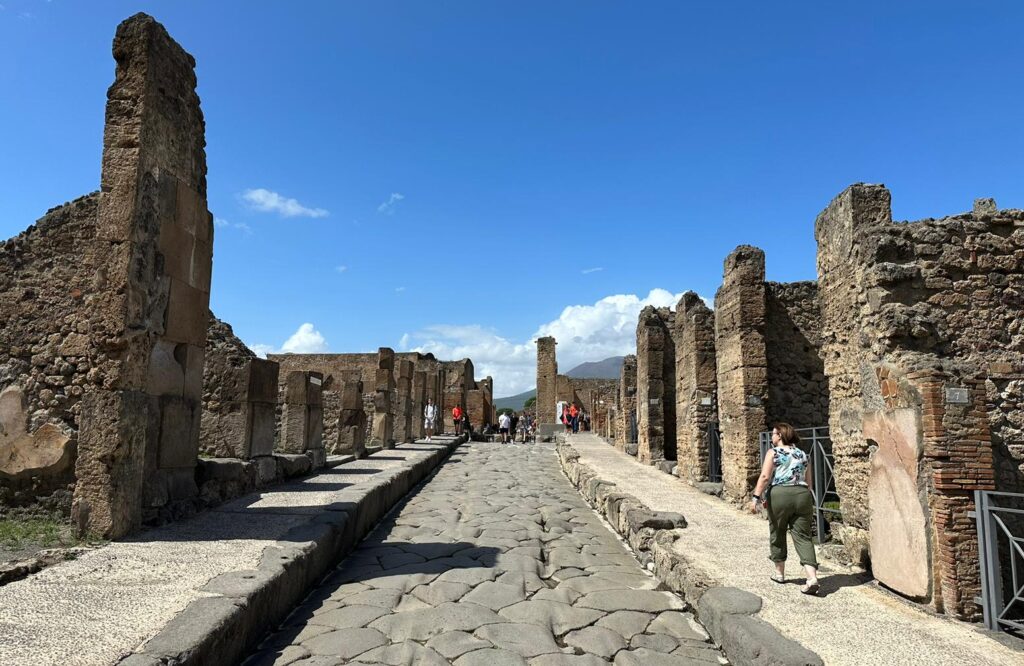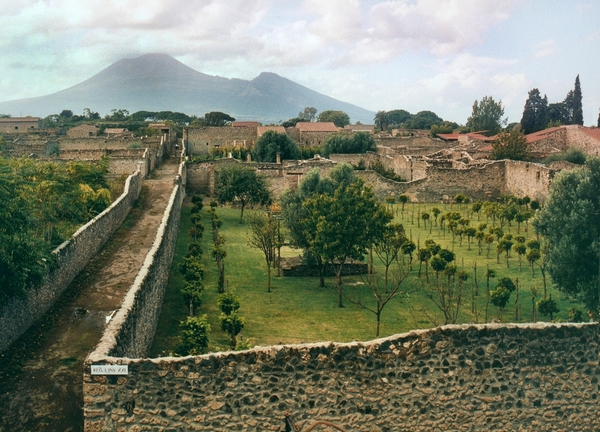One of the wonderful things about the work at Pompeii is just how much is adding to what we have understood so far. Aside from the topics which we strongly associate with the site there are other aspects, such as a Temple to Isis there. Also the fantastic work by Jashemski who set in play the examination of the gardens which has opened up a new perspective (here’s my episode where I discuss this with Dr Jess Venner). With that said there is of course the eruption and the subsequent events. These are continually being reviewed, perhaps the best example being the date of the eruption itself. However, a recent Frontiers article summarised a report in which a team of experts argued that there was evidence for an earthquake at the time Pompeii was destroyed.
As an aside I would also reccommend Pompeii Archaeological Park website which I have linked elsewhere but is worth spending some time on.
Before the eruption of Vesuvius – an early earthquake at Pompeii.
The association of seismic activity and Pompeii isn’t new, a famous earthquake at Pompeii occurred in AD 62, though there is debate that this might be dated to AD 63. It caused serious damage to buildings, including the death of 600 sheep through noxious fumes (Seneca, Natural Questions). It’s worthy of note that at the time of the destruction of Pompeii repair works were still ongoing from this event.
To understand where the earthquakes may have occurred it’s important to review the series of events at Pompeii. You can read about this here or check out the episodes on Pompeii on the Ancient History Hound podcast. Using the traditional date ascribed to the event, it’s understood that around midday of the 24th August AD 79 Vesuvius erupted and the initial mechanic was a column of ash sent high into the atmosphere. Following this material in the form of pumice and ash started to fall and this continued for around 18 hours. This event is often overlooked but in this period buildings started to collapse due to the weight of material on the roofs of buildings. The rate of pumice fall has been estimated at 15 cm/h and structural failure could have taken place once the deposits on roofs and buildings reached 40-60 cm. In short by late afternoon buildings were starting to collapse.
Roughly 30% of the fatalities so far found at Pompeii belong to this stage. It’s argued that a majority of these were caused by buildings collapsing. At the time Pompeii would have been in darkness so many people sought refuge inside, after all the outside must have been a hellish place to be in. Hot ash and pumice falling and again, the darkness.
In the early morning of the 25th the column of material firing upwards from Vesuvius started to falter and collapse. This resulted in pyroclastic flows, essentially avalanches of heated gas and rock, rolling down the side of the volcano. One almost breached the walls of Pompeii, the one which followed certainly did and caused mass casualties.
An earthquake during the eruption?
The earthquake (with others possibly occuring) argued by this team occurred just prior to those pyroclastic flows and what supported this was the damage to a wall in the casa dei Pittori al Lavaro (House of the Painters at work). It was here that the skeletons of two individuals were found and both seemingly the victims of a collapsed wall. Both were men in their 50s with one individual suffering trauma to his chest, head and pelvis. The other victim had similar injuries but may have been trying to protect himself given the additional fractures found in the bones of his arms. In both cases the small mercy was that the injuries would have been almost immediately fatal.
A technique which had been used to categorise and order the events of eruption is the stratigraphy of Pompeii. That is to say that each event from the fall of pumice to the pyroclastic flows deposited a unique layer of material, even the initial pumice fall can be subdivided. As these lay on top of each other you can allocate events and even deaths to a particular stage of the eruption. As such the team deduced that the men met their deaths after the main falling of pumice and prior to those pyroclastic flows. So how does the earthquake fit in?
The smoking wall was the internal wall which fell on the men. This wasn’t one that had collapsed early on due to the overload of material. In fact, the ceiling seems to have been intact by the time of the pyroclastic flows. In addition, the wall which collapsed wasn’t a load bearing one, meaning that even if the roof had collapsed it wouldn’t have caused the wall to fail. But what of the pyroclastic flow which did hit Pompeii, could this have caused it? There is a debate as to how damaging this would have been, though again, the team have been able to argue that even if the flow had affected this part of the building it would not have the required strength to cause it to shear and collapse.

The conclusions drawn.
The current mechanics in place don’t sufficiently explain how the wall collapsed. It wasn’t due to the accumulation of material on the roof and the pyroclastic flow wouldn’t have caused it either. However, an earthquake would supply the necessary force and in such a way to cause the wall to shear and fall on the two men. It’s the most likely candidate. With this in mind perhaps other failures in buildings could be reviewed and given that Pompeii is still revealing its secrets perhaps more evidence for earthquake damage might emerge.



